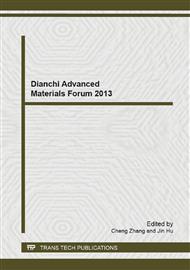p.181
p.185
p.189
p.193
p.197
p.202
p.208
p.213
p.217
Preparation of La2(CexZr1-x)2O7 Nano-Porous Powders via Citric Acid Derived Sol-Gel Processing
Abstract:
La2(CexZr1-x)2O7 powders were synthesized by the Pechini routine with citric acid as a chelating agent. TG-DTA, XRD and SEM were used to characterize as-prepared powders. Experimental results show that the crystalline structures of La2(CexZr1-x)2O7 transform to cubic fluorite phase with Ce substitution for Zr from x=0.1 to 1.0, no longer keeps the cubic pyrochlorite structure of La2Zr2O7. La2(CexZr1-x)2O7 powders present nanoporous low-density microstructurally, and successively lump-like, fluff-like and cotton-like morphologically with the increase of citric acid addition, this typical nanoporous microstructure results from a pore-crating mechanism initiated by self-propagation reactions between citric acids and nitrates. It is shown that the thermal conductivity k of powder compacts decreases sharply down from 1/10 to 1/32 of that of its single crystal bulk. as compact porosity increases from 60% to 95%. Therefore thermal barrier coatings (TBCs) of La2(CexZr1-x)2O7 with such nanoporous structures by an appropriate processing may work with quite a high insulative performance and very promising for TBC applications of high-efficiency and large propulsion engines.
Info:
Periodical:
Pages:
197-201
Citation:
Online since:
November 2013
Authors:
Price:
Сopyright:
© 2014 Trans Tech Publications Ltd. All Rights Reserved
Share:
Citation:


